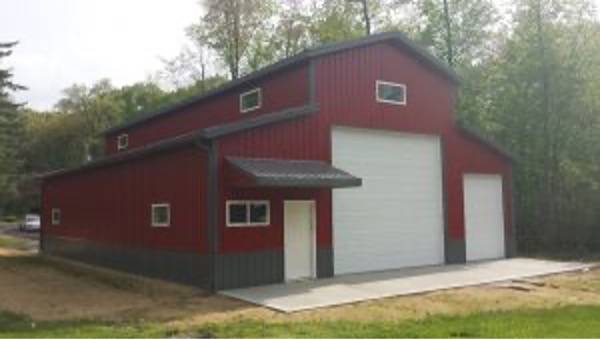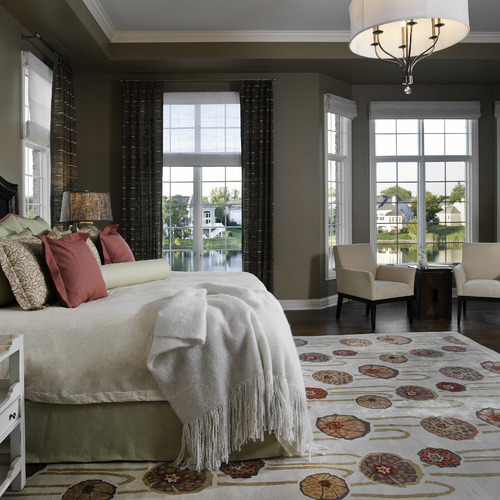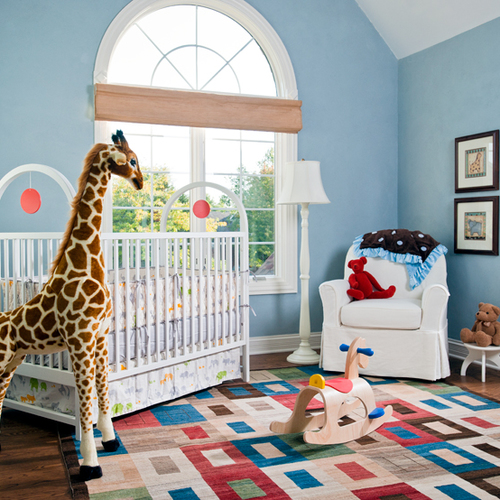Last year I had a lengthy conversation with a dear colleague and friend, Jill Salisbury, regarding a potential opportunity to educate the residential market about healthy and sustainable homes. We were frustrated with the status quo of showhouses treading the waters of “greenwashing.” Jill had the good fortune of meeting Nancy and James Chuda, founders of Healthy Child Healthy World, and was quickly inspired to pursue the idea of creating a dynamic partnership. Today, that dream is days away from fruition: The design, construction and installation of a healthy, sustainable, interactive showhouse premieres next week.
When the Healthy Home 2010: Designer Showcase & Tour opens to the public, a dream will become reality—a true success story merging passion and perseverance. Healthy Home 2010 is targeted to be the first designer showhouse in the nation to integrate green building and healthy interiors through the adoption of a new interior design protocol.
One of the most exciting aspects of Healthy Home 2010 is that it will be the first house in the nation incorporating the GREENGUARD Environmental Institute’s Indoor Environmental Quality (IEQ) Management Plan for Residential Construction: a system for creating—from the ground up—buildings that contribute to healthier indoor air. The GREENGUARD IEQ Management Plan is a perfect addition to programs like LEED for Homes. GREENGUARD-certified products support some of the most stringent indoor air quality standards, reducing airborne volatile organic compounds (VOCs), which leads to healthier indoor air quality.
In a recent press release, Henning Bloech, executive director for the GREENGUARD Environmental Institute, stated “…we’re happy to collaborate with Healthy Child Healthy World to create a healthier indoor environment for children and their families. The implementation of the new GREENGUARD Building Construction and IEQ Management Plan, which includes the use of GREENGUARD-certified products and materials, will help minimize indoor air pollutants that can negatively affect human health.”
Several of us were invited to provide guidance through the Interiors Advisory Board (IAB) to review and edit interior guidelines. These guidelines steered the product specification and selection process, providing overarching design strategies and outlining standards for use by the project team. Besides myself, members of the IAB include Penny Bonda, partner in Ecoimpact Consulting; Leslie Gage, of the GREENGUARD Environmental Institute; Leigh Anne Vandusen, owner of O Ecotextiles; Jill Salisbury, principal and founder of el: Environmental Language; and Victoria Di Iorio, education outreach coordinator for Healthy Child Healthy World.
Over the next two months, I invite you to follow this blog to find out more about the strategies and initiatives that were adopted, highlighting the following:
1) Why this project is significant to the future of healthy, sustainable residential interiors.
2) How this project bridges the gap between green construction and healthy interiors.
3) Which products with third-party certifications assure healthy indoor air quality.
4) Other environmentally responsible initiatives applied to this project.
5) How the Healthy Home 2010 embraced and balanced healthy strategies and LEED certification.
Check out Healthy Home 2010 for additional information on the home and to purchase tickets for events and tours. As a national nonprofit 501(c) 3 organization, Healthy Child Healthy World inspires parents to protect young children from harmful chemicals. For more information, please visit HCHW .
Check back soon for more!
Weekly Newsletter
Get building science and energy efficiency advice, plus special offers, in your inbox.















3 Comments
I'm a skeptic
I'm extremely leery when I hear builders make health claims for houses. I think such claims are usually unsupported by evidence, and can easily lead to litigation.
Have there been any scientific studies comparing the health of people living in houses conforming to the Healthy Home 2010 specifications with people living in ordinary homes? If so, were there any measurable health differences?
Even when it can be shown that certain homes are "unhealthy," the most important health-related factors are almost all connected with occupant behavior: smoking, use of indoor pesticides, and the choice of cleaning products. Construction specifications are way down at the bottom of the list of relevant factors.
I think the "healthy house" movement is full of red herrings and potential legal traps for unwary builders. My advice: make no health claims that are unsupported by a scientific study.
Response from Jill Salisbury
[Jill Salisbury sent in the following comments to be posted here. She wrote:]
I appreciate your skepticism regarding health claims and as we all know, it is important to question the authenticity of such claims. As Co-chair of Healthy Home 2010, I am proud of what has been accomplished through the collaborative efforts of our trusted partners and experts in the field of healthy interiors. HH10 was built on the foundation of research provided by trusted sustainable design experts, GREENGUARD Environmental Institute and supported by endless scientific studies supplied by Healthy Child Healthy World. This group of experts (Interiors Advisory Board) composed the Healthy Interiors Guidelines (HIG). Absolutely every material used for construction and interiors went through careful evaluation and had to meet the standards set by the HIG to ensure that the end result would be a healthier indoor air quality. You make a great point that there are many factors involved when maintaining the IAQ and lifestyle choices are a major consideration. This is an educational platform for consumers, designers, builders and manufacturers. Healthy Home 2010 demonstrates the importance of not only specifying low-emitting products, but also educates the visitor of healthy lifestyle choices. For example, take your shoes off at the door – 80% of all indoor grime and particulates are brought into the home on the bottom of our shoes.
All cabinets were stocked with Healthy Child Healthy World Trusted Partner organic products and chemical-free alternatives. The HH10 experience is all inclusive - from foundation to food. Every measure was taken to prevent toxic chemicals from being absorbed, inhaled, or ingested.
Per your request, please refer to the following research that supports our claims:
1 US Government Accountability Office. Chemical Regulation: Options for
Enhancing the Effectiveness of the Toxic Substances Control Act. February 2009. http://www.gao.gov/new.items/d09428t.pdf
2 Pediatric Health. Environmental Pollutants and Pediatric Asthma. June 2008. http://www.futuremedicine.com/doi/abs/10.2217/17455111.2.3.255
3 Christopher, PhD and McCally, Michael, MD, A Guide to Biomonitoring and Body Burdens of Industrial Chemicals, Center for Children’s Health and the Environment, Mt. Sinai School of Medicine, New York, NY 2001.
4 U.S. Environmental Protection Agency. Child-Specific Exposure Factors Handbook. EPA-600-P- 00-002B, September 2002.
5 Agency for Toxic Substances and Disease Registry, U.S. Department of Health and Human Services. "Healthy Children - Toxic Environments: Acting on the Vulnerability of Children Who Dwell Near Hazardous Waste Sites," Report of the Child Health Workgroup Presented April 28, 1997 to the Board of Scientific Counselors.
6 Miller, MD, MA Marty, A Arcus, J Brown, D Morry, and M Sandy. Differences Between Children and Adults: Implications for Risk Assessment at California EPA. International Journal of Toxicology, 21:403-418, 2002.
7 Tracey J. Woodruff, et al., America’s Children and the Environment, (Washington, DC: U.S. Environmental Protection Agency, 2008)
8 Holly L. Howe, et al., “Annual Report to the Nation on the Status of Cancer (1973 through 1998), Featuring Cancers with Recent Increasing Trends,” Journal of the National Cancer Institute, 93, no. 11 (June 2001): 824–42
9Janet Gray, ed, State of the Evidence: The Connection Between Breast Cancer and the Environment, (San Francisco: Breast Cancer Fund, 2008)
10Tracey J. Woodruff, et al., “Trends in Environmentally Related Childhood Illnesses,” Pediatrics, 113, no. 4 (April 2004): 1133– 1140
11Jeanne E. Moorman, et al., “National Surveillance for Asthma, United States 1980–2004,” Centers for Disease Control and Prevention, http://www.cdc.gov/mmwr/preview/mmwrhtml/ss5608a1.htm (November 1, 2009)
12Anjani Chandra and Elizabeth Hervey Stephen, “Impaired Fecundity in the United States: 1982– 1995,” Family Planning Perspectives, 30, no 1, (1998): 34–42
13Anjani Chandra, et al., “Fertility, Family Planning and Reproductive Health of US Women: Data from the 2002 National Survey of Family Growth,” Vital and Health Statistics, 23, no. 25 (2005)
14Kate Brett, “Fecundity in 2002 National Survey of Family Growth Women 15–24 Years of Age”, Hyattsville, MD, National Center for Health Statistics (2008)
15Leonard J. Paulozzi, “International Trends in Rates of Hypospadias and Cryptorchidism,” Environmental Health Perspectives, 107, no. 4, (1999): 297–302
16National Institute of Mental Health, “NIMH’s Response to New Autism Prevalence Estimate,” http://www.nimh.nih.gov/about/director/updates/2009/nimhs-response-tonew-autism- prevalence-estimate.shtml (November 4, 2009)
17National Center for Chronic Disease Prevention and Health Promotion, The Power of Prevention: Chronic Disease...the Public Health Challenge of the 21st Century, (Washington, DC: Centers for Disease Control and Prevention, 2009)
18Commission of the European Communities, “Regulation of the European Parliament and of the Council Concerning the Registration, Evaluation, Authorisation and Restrictions of Chemicals (REACH), establishing European Chemicals Agency and Amending Directive 1999/45/EC and Regulation (EC) on Persistent Organic Pollutants: Extended Impact Assessment.” (October 29, 2003): 30
19Philip J. Landrigan, et al., “Environmental Pollutants and Disease in American Children: Estimates of Morbidity, Mortality, and Costs for Lead Poisoning, Asthma, Cancer, and Developmental Disabilities,” Environmental Health Perspectives, 110, No. 7 (July 2002): 721–8
20Tom Muir and Mike Zegarac, “Societal Costs of Exposure to Toxic Substances: Economic and Health Costs of Four Case Studies That Are Candidates for Environmental Causation,” Environmental Health Perspectives Supplements, 109, No. S6 (December 2001): 885–903
Jill Salisbury
Response to Jill Salisbury
Jill,
I appreciate your comments, but I remain unconvinced.
You haven't directly answered my most important question: "Have there been any scientific studies comparing the health of people living in houses conforming to the Healthy Home 2010 specifications with people living in ordinary homes?"
Unfortunately, I have no easy access to a medical library. If the answer to my question is buried in one of the studies you cite, I would appreciate it if you could highlight that study or quote from a relevant passage.
I have looked at all of the studies that you cited which are available on the Web. They do not, in fact, point to construction details (as opposed to tobacco smoke or cleaning products) as being vitally important.
For example, here are some quotes from the studies you cited:
"No primary strategies for preventing asthma have been identified."
http://www.cdc.gov/mmwr/preview/mmwrhtml/ss5608a1.htm
"EPA Lacks Adequate Information on Potential Health and Environmental Risks of Toxic Chemicals"
http://www.gao.gov/new.items/d09428t.pdf
"Indoor environmental factors, accepted as associated with an increased risk of developing pediatric asthma, include exposure to environmental tobacco smoke [2]. Exposure to allergens, and particularly to house dust mites, has also been found to increase the risk of respiratory symptoms. Allergen-reduction studies are difficult to undertake, but even when successful, have not always shown an improvement in symptoms."
http://www.futuremedicine.com/doi/full/10.2217/17455111.2.3.255
"The hygiene hypothesis, proposed by Strachan et al., is based on the idea that exposure to viruses, bacteria or their products in early life stimulates an immune response that results in acquired immunity being moved away from development of IgE responses to environmental and food allergens."
http://www.futuremedicine.com/doi/full/10.2217/17455111.2.3.255
"Occupational exposure to cleaning agents has been consistently associated with respiratory symptoms and particularly with irritant-induced asthma."
http://www.futuremedicine.com/doi/full/10.2217/17455111.2.3.255
"Many of the chemicals now used in the home contain fragrances that merely mask odors such as tobacco smoke. It is of interest that several studies have reported that low-to-moderate exposure to artificial fragrances can significantly worsen asthma in a large percentage of asthmatic."
http://www.futuremedicine.com/doi/full/10.2217/17455111.2.3.255
By the way, this appears to be a dead link:
http://www.nimh.nih.gov/about/director/updates/2009/nimhs-response-tonew-autism-
Log in or create an account to post a comment.
Sign up Log in